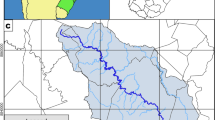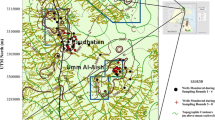Abstract
Determination of total petroleum hydrocarbon distribution (TPH) in groundwater of Dezful aquifer was the main purpose of this study. The study area, which is located between latitudes 32°00′ and 32°35′ N and longitudes 48°10′ and 49°35′ E, covers about 1,920 km2 in the north of Khuzestan Province, Iran. Hydrocarbon pollutants in the area were being released into the aquifer, from a variety of sources. An oil pipe crash accident, which occurred on 19 Feb. 2009 in the vicinity of the northern part of the study area, released about 6,000 barrels of crude oil to the Karkhe River. Other possible sources of TPH in the region are asphalt factories, gas stations, and the Sabzab oil pump station. Since the main source of drinking water in the Dezful area is groundwater reservoirs, this study would be very crucial, especially when there is considerable agricultural activity in the area as well. In order to determine the presence of TPH and heavy metals in the groundwater, samples were taken from wells with different usage within two periods, i.e., in Nov. 2008 and May 2009. The second sampling operation was carried out to determine the effect of the accident in the water resources. In situ groundwater parameter measurements including pH, dissolved oxygen, temperature, and electrical conductivity were also carried out in the field. Based on the results, there are four zones in the study area which were contaminated with TPH from different origins: (1) southeast of Dezful City, which was contaminated by Shokati gas station; (2) southeast of Shush City, which was contaminated by an asphalt factory; (3) southwest of Dezful City, which was contaminated by Sabzab oil pump station; and (4) the shores of Karkhe River which were contaminated due to the pipeline crash accident. This could be a serious threat to the environment and human health because TPH concentration was higher than the EPA standard in the study area. Heavy metals were not distributed in a uniform pattern in the aquifer. The concentrations were lower than the contamination level based on the EPA drinking standard, and there was no meaningful relation between concentrations of TPH and the heavy metals. It was recommended that a monitoring network should be designed to monitor oil contaminants in the ground and surface water monthly because of importance of the water resources and presence of potential oil contaminant sources.



Similar content being viewed by others
References
Adesodun JK, Mbagwu JSC (2008) Distribution of heavy metals and hydrocarbon contents in an alfisol contaminated with waste-lubricating oil amended with organic wastes. Bioresour Technol 99:3195–3204
Alloway BJ (1992) Land contamination and reclamation. In: Harrison RM (Ed.), Understanding our environment: An introduction to environmental chemistry and pollution (pp. 144–163). Cambridge: Royal Society of Chemistry
ATSDR (2006) Toxicological profile information sheet (Atlanta: U.S. Agency Toxic Substances and Disease Registry). http://www.atsdr.cdc.gov/toxprofiles/. Accessed 1 Sep 2010
Bence AE, Kvenvolden AK, Kennicutt MC II (1996) Organic geochemistry applied to environmental assessments of Prince William Sound, Alaska, after the Exxon Valdez oil spill—a review. Org Geochem 24:7–42
Christensen ER, Bzdusek PA (2005) PAHs in sediments of the Black River and the Ashtabula River, Ohio: source apportionment by factor analysis. Water Res 39:511–24
Doong R, Lin Y (2004) Characterization and distribution of polycyclic aromatic hydrocarbon contaminations in surface sediment and water from Gao-ping River, Taiwan. Water Res 38:1733–44
EPA (1995) Superfund program representative sampling guidance
EPA (2000) Quality assurance project plan: PM2.5 speciation trends network field sampling. Office of Air Quality, Agency Research Triangle Park, NC 27711
EPA (2003) Guidance on choosing a sampling design for environmental data collection, QA/G-5S
EPA (2006) Data Quality Assessment: Statistical Methods for Practitioners. EPA QA/G-9S, Office of Environmental Information, Washington, DC 20460
Franco MA, Vinas L, Soriano JA, de Armas D, Gonzales JJ, Beiras R et al (2006) Spatial distribution and ecotoxicity of petroleum hydrocarbons in sediments from the Galicia continental shelf (NW Spain) after the Prestige oil spill. Mar Pollut Bull 53:260–271
Gawad EA et al (2008) Assessment of the oil pollution extent in the offshore sediments, Abu Dhabi, UAE. Aust J Basic Appl Sci 2(3):617–631
IARC (International Agency for Research on Cancer) (2000) Monographs on the evaluation of carcinogenic risks to humans: some industrial chemicals, vol 77. IARC, Lyon
Iturbe R, Flores-Serrano RM, Castro A, Flores C, Torres LG (2010) Subsoil TPH contamination in two oil pipeline pumping stations and one pipeline right-of-way in north Mexico. J Environ Manag 91:2396–2402
Khuzestan Water and Power (1973) Geophysics assessments of Dezful-Andimeshk plain
Lee JY, Cheon JY, Lee KK, Lee SY, Lee MH (2001) Factors affecting the distribution of hydrocarbon contaminants and hydrogeochemical parameters in a shallow sand aquifer. J Contam Hydrol 50:139–158
Navarro A, Rossel A, Villanueva J, Grimalt JO (1991) Monitoring of hazardous waste dumps by the study of metals and solvent soluble organic chemicals. Chemosphere 22:913–928
Oros DR, Ross JRM (2004) Polycyclic aromatic hydrocarbons in San Francisco estuary sediments. Mar Chem 86:169–84
Riccardi C, Di Filippo P, Pomataa D, Incoronatoa F, Di Basilioa M, Papinib MP, Spicaglia S (2008) Characterization and distribution of petroleum hydrocarbons and heavy metals in groundwater from three Italian tank farms. Sci Total Environ 393:50–63
Roy S, Fouillac A-M (2004) Uncertainties related to sampling and their impact on the chemical analysis of groundwater. Trends in Analytical Chemistry 23(3):185–193
Shekel Y, Ravid R (1977) Sources of tar pollution on Israeli Mediterranean coast. Environ Sci Technol 11:502–5
Tolun L, Martens D, Okay OS, Schramm KW (2006) Polycyclic aromatic hydrocarbon contamination in coastal sediments of the Izmit Bay (Marmara Sea): case studies before and after the Izmit earthquake. Environ Int 32:758–65
Tyler TG (1981) Heavy metals in soil biology and biochemistry. In: Paul EA, Ladd JN (eds) Soil biochemistry. Marcel Dekker, New York, pp 22–33
US Energy Information Administration (US EIA) (2010) http://www.eia.doe.gov/cabs/iran/Full.html. Accessed 17 Feb 2012
Wang Z, Fingas MF (2003) Development of oil hydrocarbon fingerprinting and identification techniques. Mar Pollut Bull 47:423–52
Wang Z, Fingas M, Page DS (1999) Oil spill identification. J Chromatogr A 843:369–411
Wang Z, Fingas M, Lambert P, Zeng G, Yang C, Hollebone B (2004) Characterization and identification of the Detroit River mystery oil spill (2002). J Chromatogr A 1038:201–14
WHO (2008) Guidelines for drinking-water quality, third edition incorporating the first and second addenda, volume 1
Yunker MB, Macdonald RW, Goyette D, Paton DW, Fowler BR, Sullivan D et al (1999) Natural and anthropogenic inputs of hydrocarbons to the Strait of Georgia. Sci Total Environ 225:181–209
Yunker MB, Macdonald RW, Vingarzan R, Mitchell RH, Goyette D, Sylvestre S (2002) PAHs in the Fraser River basin: a critical appraisal of PAH ratios as indicators of PAH source and composition. Org Geochem 33:489–515
Author information
Authors and Affiliations
Corresponding author
Rights and permissions
About this article
Cite this article
Shahsavari, A.A., Khodaei, K., Hatefi, R. et al. Distribution of total petroleum hydrocarbons in Dezful aquifer, Southwest of Iran. Arab J Geosci 7, 2367–2375 (2014). https://doi.org/10.1007/s12517-013-0887-4
Received:
Accepted:
Published:
Issue Date:
DOI: https://doi.org/10.1007/s12517-013-0887-4




